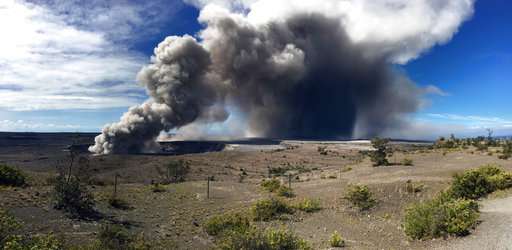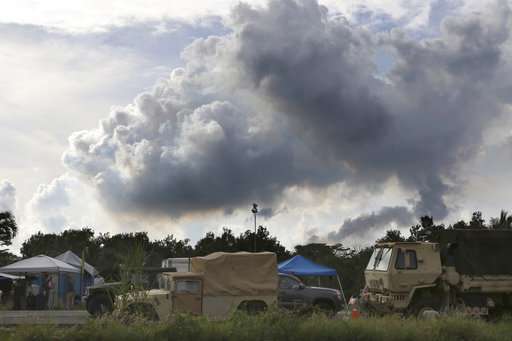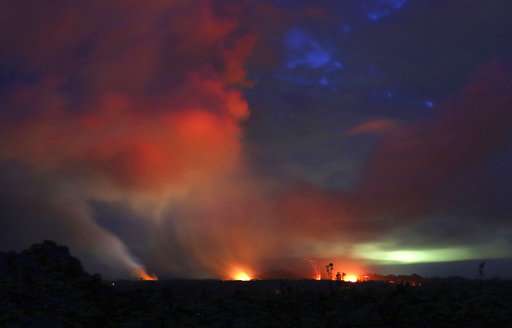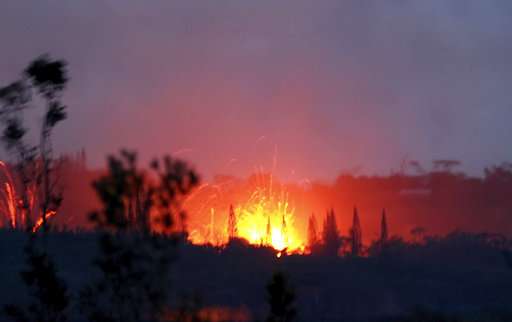Scientists study lava for clues to how volcano will behave

Whether spewing from the ground in red plumes or crawling in a fiery blob across neighborhoods, lava from the Kilauea volcano has produced the most arresting images of the recent eruption. But not all lava is created equal, and the differences could offer hints about the volcano's behavior.
For instance, the age of lava and the rate at which it bursts out can provide clues about the length and intensity of volcanic activity.
As the eruption sputters into a third week, scientists are examining lava samples and trying to understand what might be happening deep under the mountain. A closer look at the molten rock:
WHAT IS LAVA?
Lava is molten rock, or magma, that reaches the earth's surface in a slush of crystals and bubbles of volcanic gases. Its chemical composition includes silicon, aluminum, oxygen, and iron.
Hawaii volcanoes are known for two main types of lava flows. The first, called a'a, is generally characterized by lava that flows fast and cools quickly, creating a jagged, rough surface. The other type of lava is called pahoehoe, which cools more slowly and leaves a smooth, billowy surface as it creeps across land.
WHERE DOES IT COME FROM?
Much of the lava that has emerged was thought to have been underground for decades, since a 1955 eruption, said U.S. Geological Survey scientist Steve Brantley. That lava has bubbled up through about 20 fissure vents and forced thousands of people to evacuate. More than two dozen homes have been destroyed.

But new samples collected this week are newer, younger lava, and scientists are working to understand the significance of that finding.
"When this eruption first started (on May 3), one of the biggest outstanding questions was—is there new lava that's being pumped into the volcano from deep within the earth, or is this old lava that has been sitting?" said Tracy Gregg, an associate professor of geology at the University of Buffalo.
"You can think of it as sitting in a bucket. Someone has pulled the plug on the bucket, and the bucket is draining down," Gregg said. At the same time, there could be a "constant, slow production of new lava beneath Kilauea filling the bucket."
WHY IS THERE OLD LAVA?
Magma is always lurking under the surface of Kilauea, but it won't come out unless subterranean pressure pushes it out.
A crater on the volcano recently started "inflating," which indicates the growing presence of lava in an underground reservoir. Inflation can cause the land to bulge or deform. Similarly, as magma leaves a chamber, potentially to erupt, the ground can also "deflate."
The inflation suggested pressure was building below ground. The crater floor eventually collapsed, forcing magma that had probably been sitting there since 1955 up through the surface, said USGS scientist Wendy Stovall.

"If magma sits around for a little while, it becomes kind of old and sticky, and it forms crystals," she said. "It's really sluggish, and it's not very voluminous in the way it comes out."
Indeed, the lava oozing out of the ground has been moving at a relatively slow pace as it destroys homes and covers roads.
HOW IS NEW LAVA DIFFERENT?
Younger lava is generally hotter and more liquid, as it has higher amounts of gas and fewer crystals. "That creates a more fluid and dynamic lava at the surface," Stovall said.
This type of lava will flow faster, meaning it could more quickly cut off evacuation routes and take over neighborhoods with less warning.
The volume of lava and the pace at which it erupts can provide some indication on the duration and intensity of an explosive eruption, Gregg said.
A dramatic increase of lava splattering like fireworks from the ground might mean the volcano is just getting started and the eruption won't end anytime soon.

HOW DO SCIENTISTS ESTIMATE THE AGE OF LAVA?
Scientists have been collecting lava rock samples to examine the crystals embedded within to look for a chemical "signature." That allows them to compare previous samples collected at different times, Stovall said.
The comparisons could help shed light on the volcano's inner workings, but researchers have not drawn any conclusions yet.
Lava rock can even have a specific appearance and a unique collection of minerals that allow experts to infer a certain age or type of lava, Gregg said. Another test is to measure the rate of radioactive decay of certain elements in the rocks, also known as carbon dating.
© 2018 The Associated Press. All rights reserved.
















